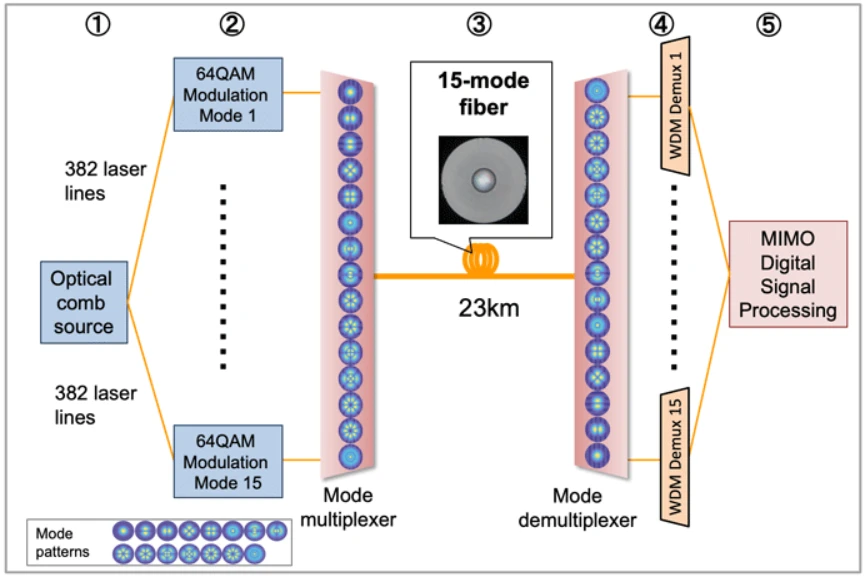An increase in data transmission requirements can be seen around the world, and a number of studies have been conducted in optical transmission systems over the past decade.
In a previous article we reported on the data transmission record of
178Tb/s. This time, we are pleased to report a
new data transmission record set by the
National Institute of Information and Communications Technology (NICT) in Japan.
A team of researchers led by George Rademacher (NICT, Japan), Nicolas K. Fontaine (NOKIA Bell Labs, USA) and Pierre Sillard (Prysimian Group, USA) succeeded
in the world's first transmission exceeding 1 petabit per second, in a single core multimode optical fiber.
The study demonstrated the feasibility of combining highly efficient broadband optical transmission spectra with a fiber optic cable (15 modes) with a jacket diameter consistent with the current industry standard of 0.125nm. The transmission was successfully put together over a
distance as long as 23km!
① 382 carrier lines are generated in a single optical source
② 15 x 382 carrier lines are modulated with 64 QAM signals
③ Each of the 15 mods is run in a different fiber mode
④ Wavelength filters extract one WDM channel from all fiber mods
⑤ MIMO processing is performed considering signals from all 15 fiber mods
What is a petabit?
1 petabit is 1000 trillion bits, 1 terabit is 1 trillion bits, and 1 gigabit is 1 billion bits. One petabit per second is equivalent to 10 million channels of 8K transmission per second.
15 mod fiber
The transmission optical fiber shown in the above figure (cross section) has a core diameter of 0.028mm and a standard jacket diameter of 0.125mm. The optical fiber is designed to allow propagation of 15 fiber mods and to minimize the propagation delay difference between all 15 mods.
The current record data rate to date has been 0.4 petabits per second in 10-mode multimode fiber.
Experiment
The experiment was entirely designed and conducted at NICT headquarters. Prismian transmission fiber and modal multiplexers developed by Bell Labs were used. A wideband transmit/receive subsystem was developed at Japan's NICT, which is used (as the name suggests) to transmit and receive hundreds of highly spectral WDM channels with high signal quality. "The transmission fiber was 23km long and had a graded-index design. It was based on existing multimode fibre designs that were optimised for broadband operation and had a jacket diameter of 0.125mm and a sheath diameter of 0.245mm, both of which conform to the current industry standard."
Of course, it should be kept in mind that when increasing the number of mods in a multimode fiber transmission system, the digital processing of the MIMO signal increases because of the computational complexity required. In an experiment conducted by NICT a transmission fiber was used that had small modal delays. This simplified the MIMO complexity and kept modal delays low over a large optical bandwidth. All this made it possible to realize transmission of 382 channels, each modulated by a 64-QAM signal.
The figure above shows the data rates for all 382 WDM channels after implementing forward error correction.
Summing the data rates for all wavelength channels yields a total data rate of 1.01 petabits per second. CONGRATULATIONS!
Author:
Leszek Błaszczyk
 Click to enlarge!
Click to enlarge!
 Click to enlarge!
Click to enlarge!
 Click to enlarge!
Click to enlarge!
 Click to enlarge!
Click to enlarge!